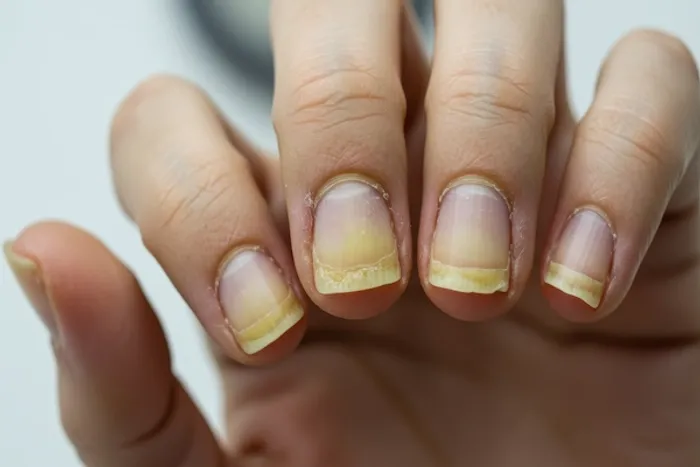What Leads to Nail Infection? Causes, Risks, and Proven Fixes
Know about the nail infection, what it is who gets it, causes, symptom, diagnosis and treatment options and more.


Introduction
A nail infection can start with something as small as a hangnail or a sweaty workout—and slowly turn into thick, discoloured, brittle nails that snag on socks and shoes. Fungal nail infection (onychomycosis) is the most common type, but bacteria and viruses can also infect the skin around your nails, causing pain and swelling. Understanding what actually leads to a nail infection is the key to stopping it early—and preventing it from coming back. In this guide, you’ll learn the science-backed causes and risk factors, the tell-tale signs of each kind of nail infection, how doctors diagnose them, and which treatments work best in the real world. You’ll also get a step-by-step plan for care, salon and hygiene tips, and special considerations if you have diabetes or spend lots of time in pools and gyms. If you’re dealing with a stubborn nail infection now, or just want to avoid one, this article will help you take confident, informed next steps.
Nail Infection: What It Is and Why It Matters
Nail infections fall into three broad categories—fungal, bacterial, and viral—and each behaves a little differently in terms of how it starts, how it looks, and how it’s treated.
- Fungal nail infection (onychomycosis). This is the most common nail infection. It’s often caused by dermatophyte fungi such as Trichophyton rubrum and can spread from athlete’s foot to the toenails. Nails gradually turn yellowish or white, thicken, become brittle or crumbly, and may lift from the nail bed. Toenails are affected more than fingernails; risk rises with age, moisture, and chronic conditions like diabetes.
- Bacterial nail infections. Acute paronychia is a sudden, painful bacterial infection of the skin fold next to the nail (the lateral or proximal nail fold). It often follows a hangnail, nail biting, or a manicure mishap, and commonly involves Staphylococcus aureus; the area becomes red, swollen, and may form a pus pocket. Chronic paronychia involves prolonged inflammation from wet work and irritation, often with Candida (yeast) playing a role. Green nail syndrome is caused by Pseudomonas bacteria and shows a characteristic greenish discolouration under the nail.
- Viral infections. Herpetic whitlow is a painful viral infection (HSV-1 or HSV-2) of the finger around the nail, causing grouped fluid-filled blisters; it’s important not to incise these because the virus can spread and worsen.
- Why it matters: Untreated nail infection can cause persistent pain, difficulty walking, secondary skin infections like cellulitis, and impact daily activities. In those with diabetes or poor circulation, complications can escalate.
Nail Anatomy and How Infections Take Hold
The nail unit is a clever barrier system. The nail plate (hard keratin) sits on the nail bed, growing from the matrix hidden under the proximal nail fold. Cuticles seal the gap between the plate and fold, acting like caulking to keep moisture and microbes out.
How defenses fail:
- Microtrauma. Repetitive tapping, long-distance running, tight shoes, or aggressive cuticle trimming create tiny breaks that let organisms in.
- Moisture. Fungi and bacteria love warm, damp environments. Sweat trapped in non-breathable shoes, frequent hand washing, or dishwashing without gloves macerates skin and weakens defenses..
- Seeding from nearby infections. Athlete’s foot (tinea pedis) is a common source; fungal spores migrate to the nails, turning a skin infection into a stubborn nail infection
- The role of athlete’s foot: If you have itchy, scaly soles or peeling between toes, that can be the launchpad for a fungal nail infection. Treating tinea pedis and disinfecting shoes reduces reinfection risk.
Risk Factors You Can Change—and Those You Can’t
Some risks are baked in; others are highly modifiable.
1. Lifestyle and environmental risks:
2. Occlusive footwear and sweaty feet (hyperhidrosis) keep nails damp.
3. Locker rooms, public pools, and gym showers increase exposure to fungal spores.
4. Nail salons with inadequate instrument sterilisation or aggressive cuticle removal raise bacterial and fungal risk.
Nail biting, picking at hangnails, and DIY cuticle cutting create entry points.
Medical risks:
1. Diabetes, peripheral vascular disease, and lymphedema reduce circulation and immune response, increasing severity and complication risks [3][4].
2. Immunosuppression (e.g., steroids, chemotherapy, HIV).
Nail psoriasis or eczema can mimic a fungal infection or coexist, and the damaged nail is more prone to infection.
Consult a Top Dermatologist for Personalised Advice
Nail cosmetics:
Gels, acrylics, and glue-on nails can trap moisture, hide early signs, and cause microtrauma when applied or removed. Roughing the nail plate for adhesion thins the barrier. UV-cured gels don’t cause infection by themselves, but can make detection and airing difficult if problems start underneath.
Symptoms and Red Flags: When Is It a Nail Infection?
Fungal nail infection symptoms:
Gradual color change (yellow, white, brown), thickening, brittleness, crumbling edges, and detachment from the nail bed (onycholysis). Mild odor can occur. Discomfort in shoes is common as thickness increases.
Acute bacterial paronychia:
Rapid swelling, redness, and throbbing pain along the nail fold, often after a hangnail or manicure. A pus pocket may form and needs professional drainage if large [4].
Chronic paronychia:
Recurrent redness and swelling of the nail fold lasting weeks or months, often in people with chronic wet work. The cuticle disappears and the nail becomes ridged or distorted. Often involves Candida as well as irritant dermatitis [4].
Green nail syndrome:
Greenish discolouration under the nail due to Pseudomonas. Often in those with frequent wet exposure (e.g., dishwashers, swimmers)
Herpetic whitlow:
Tingling pain followed by clusters of small blisters on a finger near the nail. Do not lance. Antivirals may help, and preventing spread is key [4].
Red flags—seek care promptly:
1.Spreading redness, warmth, severe pain, fever, or red streaks up the finger/foot (possible cellulitis).
2.If you have diabetes, poor circulation, or are immunocompromised and develop any nail infection signs.
3.If a “fungal” nail infection becomes rapidly painful or swollen—it may not be fungal.
If symptoms persist beyond two weeks, consult a doctor online with Apollo24|7 for further evaluation. Persistent pain, pus, or green discolouration warrants an in-person assessment.
Getting a Diagnosis the Right Way
Why testing matters: Many nail problems look alike. Treating a non-fungal issue with antifungals wastes months. A quick test can save time and money .
Clinical exam and tests:
1.KOH microscopy: A small scraping or clipping is examined under a microscope for fungal elements. Fast and inexpensive.
2.Culture and species identification: Helps guide treatment if initial therapy fails or unusual organisms are suspected. Results take longer
3. Nail clipping with PAS stain: A pathology lab examines a nail fragment; sensitive for detecting fungi [4].
4.For paronychia, diagnosis is typically clinical; pus may be cultured when severe or recurrent.
Differential diagnoses:
Nail psoriasis, lichen planus, eczema, trauma-induced onycholysis, and exogenous staining can mimic fungal nail infection. A clinician can differentiate these—or confirm with testing.
When to consult and what to expect:
If you’re unsure of the cause or symptoms are significant, get evaluated. If your condition does not improve after trying these methods, book a physical visit to a doctor with Apollo 24|7. If you have recurrent infections, screening for underlying issues like diabetes may be prudent; Apollo24|7 offers convenient home collection for tests like HbA1c or vitamin D as part of broader health assessments.
Treatment That Works: Fungal Nail Infection
Topical treatments (best for mild or early disease, especially fingernails):
- Antifungal nail lacquers/solutions (e.g., ciclopirox, efinaconazole, amorolfine) applied daily for 6–12 months can clear mild cases. Success rates vary and are generally lower than oral therapy, but side effects are minimal. Mechanical debridement (thinning the nail) increases penetration. Long-tail: antifungal nail lacquer effectiveness.
Oral antifungals (more effective for moderate–severe, multiple nails, or toenails):
Terbinafine is often the first choice for dermatophyte infections; the typical course is 6 weeks for fingernails and 12 weeks for toenails. Itraconazole is an alternative (pulse or continuous regimens).
Evidence: Systematic reviews show oral agents have higher mycologic cure and clinical improvement rates than topicals alone, particularly for toenails [5]. Discuss potential interactions and liver considerations with a clinician. Long-tail: oral terbinafine side effects.
Treating Bacterial and Viral Nail Infections
1. Acute paronychia (bacterial):
- Early, mild cases: Warm water or antiseptic soaks (e.g., diluted antiseptic solutions) several times daily, elevation, and avoiding further trauma. If a pus pocket forms, a clinician may perform a small incision for drainage. Short courses of antibiotics are used when cellulitis is present or in moderate to severe cases.
- Avoid aggressive cuticle cutting; keep the area clean and dry.
Chronic paronychia:
The cornerstone is minimising moisture and irritants: glove protection with cotton liners, gentle skincare, and stopping cuticle manipulation. Topical anti-inflammatory therapies and antifungals may be used; treating any Candida overgrowth can help [4].
Green nail syndrome (Pseudomonas)
Often improves with keeping the nail dry and using topical anti-pseudomonal agents (e.g., acetic acid soaks with diluted white vinegar as advised by a clinician). Trimming back the detached nail reduces the niche where bacteria reside. Severe or persistent cases may need prescription therapies.
Herpetic whitlow:
Painful grouped vesicles near the nail due to HSV. Do not incise. Antiviral therapy may be prescribed, especially if started early. Keep the area covered to prevent spread to others (or to other body sites).
Prevention and Daily Care: Keep Nail Infection Away
Footwear and sweat control:
- Choose breathable shoes and rotate pairs to allow 24–48 hours of drying time.
- Use moisture-wicking socks; change midday if feet sweat heavily. Antifungal shoe sprays or UV shoe sanitisers can reduce fungal load. Nail and household hygiene.
- Keep nails short and clean; file down thick areas gently to reduce trauma. Don’t share nail clippers, files, or towels. Wash and dry between toes carefully after showers. Treat athlete’s foot promptly to prevent spread to nails
Salon safety checklist:
- Ensure tools are sterilised between clients (ask about autoclaves or single-use instruments).
- Avoid aggressive cuticle cutting; request gentle pushing back only, or skip cuticle work entirely.
- Skip services if you have open cuts, hangnails, or a current nail infection; cover damaged skin until healed.
- For gels/acrylics, schedule polish-free “holidays” to inspect the nail and let it breathe.
Myths vs. Facts: Natural Remedies and Internet Advice
Vinegar and acetic acid:
- Mild acetic acid can help Pseudomonas-related green nail and may reduce bacterial load around the nail folds, but it is not a reliable cure for fungal nail infection inside the nail plate. Always dilute and follow clinical advice [4].
Tea tree oil:
Limited and mixed evidence for nail fungus; potential for skin irritation. If used, spot test and discontinue if irritation occurs. Do not rely on it for moderate to severe infections [5].
Vicks and home rubs:
Anecdotes abound, but robust evidence is limited. These may soften nails and change odour, witthout reliably eradicating fungus in the nail plate.
Why “trimming hard” can backfire:
Aggressive digging under the nail can separate the plate from the bed (onycholysis), creating a warm pocket for fungus or bacteria. Gentle filing and clinician-guided debridement are safer.
Over the next 4–12 weeks:
- For suspected mild fungal nail infection, consider a topical antifungal lacquer; thin thick areas gently for better penetration. If no visible improvement in 6–8 weeks, or multiple nails are involved, consult a clinician.
- For painful, swollen nail folds (paronychia), use warm soaks. If pus develops or pain worsens, seek care promptly.
Conclusion
A nail infection rarely happens “out of the blue.” It’s usually the result of exposure (to fungi, bacteria, or viruses) plus an opportunity—like moisture, microtrauma, or a compromised barrier. Understanding those mechanics lets you take targeted steps: keep the nail environment dry, avoid aggressive cuticle work, disinfect tools, and treat athlete’s foot early. When infection strikes, matching the treatment to the cause is crucial. Topical lacquers and meticulous care can help early fungal nail infection, while oral antifungals are better for thick, multi-nail, or long-standing infections. Bacterial paronychia needs warm soaks and, sometimes, drainage or antibiotics; green nail and herpetic whitlow follow their own playbooks. Above all, be patient—nails grow slowly, and visible improvement takes months. If you’re unsure what you’re seeing or you’re at higher risk due to diabetes or circulation issues, getting a timely diagnosis can save you months of guesswork. If symptoms persist beyond two weeks or you need personalised treatment, consult a doctor online with Apollo24|7, or book a physical visit for hands-on care. With the right plan and a few smart habits, you can clear the current infection and keep future ones at bay.
Consult a Top Dermatologist for Personalised Advice
Consult a Top Dermatologist for Personalised Advice
Dr. Kavitha Killaparthy
Dermatologist
23 Years • MBBS,DIPLOMA(DERMATOLOGY,VENEREOLOGY,LEPROSY)
Hyderabad
JDS Skin & Hair Clinic, Hyderabad
Dr. Mayuri Jain
Dermatologist
11 Years • MBBS, MD Dermatology , Venereology & Leprosy
Delhi
Dr Mayuri Jain Clinic, Delhi

Dr Ekansh Shekhar
Dermatologist
10 Years • MBBS MD
Lucknow
Apollo Clinic Hazratganj, Lucknow
Dr.j Girishma
Dermatologist
6 Years • MBBS MD DERMATOLOGY
Bengaluru
Apollo Medical Center, Marathahalli, Bengaluru
Dr. Praveen Kumar
Dermatologist
5 Years • MBBS, MD DVL
Yenugonda
SVS Hospital ., Yenugonda
Consult a Top Dermatologist for Personalised Advice
Dr. Kavitha Killaparthy
Dermatologist
23 Years • MBBS,DIPLOMA(DERMATOLOGY,VENEREOLOGY,LEPROSY)
Hyderabad
JDS Skin & Hair Clinic, Hyderabad
Dr. Mayuri Jain
Dermatologist
11 Years • MBBS, MD Dermatology , Venereology & Leprosy
Delhi
Dr Mayuri Jain Clinic, Delhi

Dr Ekansh Shekhar
Dermatologist
10 Years • MBBS MD
Lucknow
Apollo Clinic Hazratganj, Lucknow
Dr.j Girishma
Dermatologist
6 Years • MBBS MD DERMATOLOGY
Bengaluru
Apollo Medical Center, Marathahalli, Bengaluru
Dr. Praveen Kumar
Dermatologist
5 Years • MBBS, MD DVL
Yenugonda
SVS Hospital ., Yenugonda
More articles from General Medical Consultation
Frequently Asked Questions
What’s the fastest way to treat a fungal nail infection?
There’s no instant fix. Oral terbinafine typically clears fungus faster and more effectively than topicals for moderate to severe onychomycosis, but nails still need months to grow out. For mild cases, topical antifungal nail lacquer plus regular thinning can work over 6–12 months [1][5].
How do I know if it’s paronychia or a fungal nail infection?
Paronychia is a swollen, painful nail fold that can develop quickly—often with pus—after a hangnail or manicure. Fungal nail infection changes the nail plate itself, causing thickening and yellowing over weeks to months. If you see pus or severe pain, seek care promptly [4].
Can nail salons cause nail infections?
Poorly sterilised instruments and aggressive cuticle cutting increase risk. Choose salons that use an autoclave or single-use tools, avoid services if you have open skin, and consider skipping cuticle cutting. This reduces bacterial and fungal nail infection risk [1][4].
Do home remedies like tea tree oil or vinegar cure nail fungus?
Evidence is limited and mixed. Some may help surface symptoms or certain bacterial issues (like dilute acetic acid for green nail), but they usually don’t penetrate the nail plate enough to eradicate fungus. Proven antifungals are more reliable [4][5].
When should I see a doctor about a nail infection?
ASee a clinician if there’s severe pain, spreading redness, pus, fever, diabetes, poor circulation, or if symptoms persist beyond two weeks. If home care isn’t helping, consult a doctor online with Apollo24|7 for diagnosis and tailored treatment.




